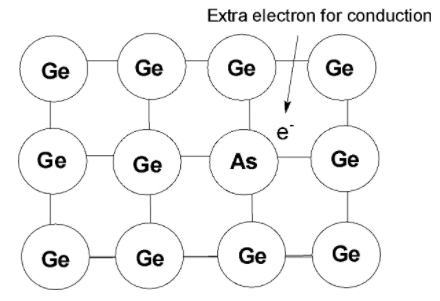
To get n-type of semiconductor, germanium should be doped with:
A) Gallium
B) Arsenic
C) Aluminium
D) Boron
Answer
437.1k+ views
1 likes
Hint: In an n-type semiconductor, the group 15 elements are added as the dopant or as an impurity to the silicon or germanium. The four electrons form a bond with the adjacent silicon and the extra electron is responsible for the conduction of electricity.
Complete answer:
> Semiconductor elements like silicon
> It is possible to increase the charge carriers by the introduction of an impurity called ‘dopant’ in the semiconductor. This process is called doping. Doping changes the intrinsic semiconductor to an extrinsic semiconductor.
> Pure silicon or germanium can be made more conducting by adding the dopant impurities. Dopants act as either an electron donor or acceptor. If a donor has more valence electrons then they donate the extra electron for the conduction of electricity.
> Silicon and Germanium are group 14 elements. The group 15 elements have the last shell configuration
> An extremely small number of atoms of the silicon or germanium is replaced by the arsenic atom. The four-electron out of the five electrons forms a bond with the silicon in its framework. Only four electrons are engaged in bond formation. The fifth electron is not bonded. On the application of electricity, the free electron acts as a charge. The electricity experienced by this doped semiconductor is greater than that of the intrinsic semiconductor.
> Since the extra electron is responsible for the conduction is called the n-type of the semiconductor. The term n-type comes from the negative charge in the silicon framework. In n-type semiconductors, the electrons are the carriers of electricity. Common types of dopants are phosphorus or arsenic.
> In n-type semiconductors, the extra band named as the donor band is added in the between the conduction and valence band. This makes it easy for the excitation of an electron from the donor band to the conduction band.

Thus the arsenic is doped to form n-type semiconductor.
Hence, (B) is the correct option.
Note: Do not get confused with the n and p-type of the semiconductor. The n stands for the extra electron or negative carrier and the p is termed use for the hole or positive carrier. Extra electron, when doped with a higher group element and hole, is generated when doped with lower group elements.
Complete answer:
> Semiconductor elements like silicon
> It is possible to increase the charge carriers by the introduction of an impurity called ‘dopant’ in the semiconductor. This process is called doping. Doping changes the intrinsic semiconductor to an extrinsic semiconductor.
> Pure silicon or germanium can be made more conducting by adding the dopant impurities. Dopants act as either an electron donor or acceptor. If a donor has more valence electrons then they donate the extra electron for the conduction of electricity.
> Silicon and Germanium are group 14 elements. The group 15 elements have the last shell configuration
> An extremely small number of atoms of the silicon or germanium is replaced by the arsenic atom. The four-electron out of the five electrons forms a bond with the silicon in its framework. Only four electrons are engaged in bond formation. The fifth electron is not bonded. On the application of electricity, the free electron acts as a charge. The electricity experienced by this doped semiconductor is greater than that of the intrinsic semiconductor.
> Since the extra electron is responsible for the conduction is called the n-type of the semiconductor. The term n-type comes from the negative charge in the silicon framework. In n-type semiconductors, the electrons are the carriers of electricity. Common types of dopants are phosphorus or arsenic.
> In n-type semiconductors, the extra band named as the donor band is added in the between the conduction and valence band. This makes it easy for the excitation of an electron from the donor band to the conduction band.

Thus the arsenic is doped to form n-type semiconductor.
Hence, (B) is the correct option.
Note: Do not get confused with the n and p-type of the semiconductor. The n stands for the extra electron or negative carrier and the p is termed use for the hole or positive carrier. Extra electron, when doped with a higher group element and hole, is generated when doped with lower group elements.
Latest Vedantu courses for you
Grade 11 Science PCM | CBSE | SCHOOL | English
CBSE (2025-26)
School Full course for CBSE students
₹41,848 per year
EMI starts from ₹3,487.34 per month
Recently Updated Pages
Master Class 9 General Knowledge: Engaging Questions & Answers for Success

Master Class 9 English: Engaging Questions & Answers for Success

Master Class 9 Science: Engaging Questions & Answers for Success

Master Class 9 Social Science: Engaging Questions & Answers for Success

Master Class 9 Maths: Engaging Questions & Answers for Success

Class 9 Question and Answer - Your Ultimate Solutions Guide

Trending doubts
Give 10 examples of unisexual and bisexual flowers

Draw a labelled sketch of the human eye class 12 physics CBSE

Differentiate between homogeneous and heterogeneous class 12 chemistry CBSE

Differentiate between insitu conservation and exsitu class 12 biology CBSE

What are the major means of transport Explain each class 12 social science CBSE

a Tabulate the differences in the characteristics of class 12 chemistry CBSE




